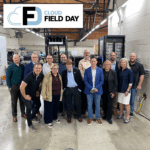|
|
This video is part of the appearance, “Pure Storage Presents at Cloud Field Day 24“. It was recorded as part of Cloud Field Day 24 at 8:00-9:30 on October 22, 2025.
Watch on YouTube
Watch on Vimeo
Pure Fusion, built into the Purity operating environment, is a core enabler of the Enterprise Data Cloud architecture. Fusion federates arrays into a single, unified fleet and uses outcome-driven automation through Presets to ensure consistent provisioning and configuration of workloads across environments. The result: a self-service, API-driven platform that lets users manage data—not storage—across their hybrid cloud.
The presentation details the evolution of Pure Fusion to version 2, emphasizing its integration with Purity and its role in enabling the Enterprise Data Cloud architecture. A key goal is to shift the focus from managing storage infrastructure to managing data across on-premises and cloud environments. Fusion V2 prioritizes backward compatibility, allowing existing customers to leverage its benefits without requiring extensive script rewrites or retraining. Furthermore, it caters to “dark site” customers by integrating the control plane into Purity, eliminating the need for cloud connectivity while offering workload-placement recommendations through Pure One.
Fusion simplifies storage management through presets, which are declarative definitions of desired outcomes. Storage administrators and consumers can define their requirements in these presets, enabling Fusion to automate provisioning, configuration, and monitoring of workloads. The introduction of the “fleet” concept allows multiple arrays, including FlashArray, FlashBlade, and Pure Storage Cloud, to communicate and coordinate, enabling consistent application of presets across the entire data estate. This unified approach facilitates a shift from managing individual arrays to managing the fleet as a whole, streamlining operations and reducing the risk of misconfigurations.
The presentation showcased a demo of workload provisioning using presets, highlighting how junior administrators can easily deploy and configure databases with predefined settings, ensuring consistent, compliant configurations. The ability to tag resources with billing IDs facilitates chargeback and showback processes, while a compliance engine monitors for configuration drift and enables remediation. Also showcased was the potential of using Fusion with AI language models to automatically provision storage for Machine Learning training workloads. Fusion provides a framework for achieving objective-based management across multiple use cases, including MSPs, standardization, and provider-consumer separation.
Personnel: Brent Lim








